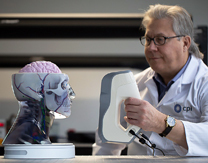 |
Date Announced: 06 May 2021
Employee at CPI’s National Healthcare Photonics Centre utilising an anatomical model made with Laser Lines’ 3D printing technology.
Banbury, UK -- Laser Lines, the UK’s most established reseller of 3D printers and materials, today announces it has installed the Stratasys J750 Digital Anatomy 3D Printer in CPI’s National Healthcare Photonics Centre.
The Centre is a unique combination of bio-labs and instrument development facilities where companies can work alongside CPI staff in state-of-the-art facilities for the development of medical technology using photonics.
The Centre, which was supported with a £7.9m grant from the Government’s Local Growth Deal through the North East Local Enterprise Partnership, includes capabilities in optical system design and test (including testing with ionising radiation or x-rays), imaging, printing and manufacture.
Personalised care
Trends in the MedTech market are changing to meet the requirement for more personalised and less invasive care, moving away from hospital-based services. New approaches in imaging and diagnostics therapies are helping to meet these challenges.
The Stratasys J750 Digital Anatomy 3D Printer is part of this trend, enabling the production of realistic body parts based on actual patient-specific scan data. Multi-material anatomical models, constructed using the data captured by hospital imaging systems, let surgical teams, consultants and their patients make better-informed decisions before embarking on surgery or a treatment regime.
Wayne Morton, senior mechanical design engineer at CPI, says: “Anatomy is incredibly difficult to design and replicate. Trying to model a human with a particular injury or syndrome using traditional techniques has been virtually impossible until now.
“The new Digital Anatomy 3D Printer gives us precise control over what we are designing and developing as we can now manufacture model parts directly from data obtained by medical imaging methods such as CT scanning or MRI. It is a very valuable tool for our partners to benefit from as part of the design and prototyping phase of medical device development.”
Identical copies
CPI’s investment means that it can now use actual patient data to print several identical copies of a patient’s body part. For example, surgeons who want to be able to practise before an operation takes place can print an exact replica of the patient’s organ with all of its anomalies. The surgeon can print the part as many times as needed before the procedure. Previously, animal, cadaver, and synthetic models would have been used to practise with, which can be costly and difficult to manage.
Wayne adds: “We can convert data from medical scans, such as MRI, into a solid design file and then be able to print someone's actual skull, not just something that is an approximation. This is an incredible advance for a surgeon because several copies of that anatomical part can be manufactured, enabling the surgeon to plan the procedure and optimise patient care.”
The Stratasys J750 Digital Anatomy 3D Printer produces incredibly realistic representations that can be used as both visual and functional models. Using base materials that have been exclusively produced for this printer, users can create models that look and feel like human tissue. The Stratasys J750 Digital Anatomy 3D Printer can also help to verify medical devices faster, enabling companies to get their products to market more quickly and for patients to benefit from new technologies earlier.
The machine can reduce overall costs by up to 70% compared to conventional models. The materials can all be printed to different sizes, strengths and resistances to create unparalleled accuracy down to a thickness of 1 mm for vascular system walls. For rigid geometry, the system can print even finer layers to a thickness of 14 microns.
Wayne says: “There are a lot of benefits we will see from the 3D printer, so we are extremely excited to have the first unit in the UK and to be able to share this capability with our partners. Now, we can print with certified biocompatible materials when we are making a wearable device enclosure. This means we can be confident that the patient will be able to use it for up to 30 days without getting rashes or irritation.
E-mail: 3dworld@laserlines.co.uk
Web Site: 3dprinting.co.uk
| © 2026 SPIE Europe |
|